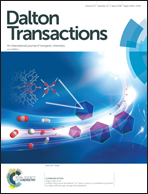[Ru3(6-NHC)(CO)10]: synthesis, characterisation and reactivity of rare 46-electron tri-ruthenium clusters†
Abstract
[Ru3(CO)12] reacts at room temperature with N-alkyl substituted 6-membered ring N-heterocyclic carbenes (6-NHC) to form [Ru3(6-NHC)(CO)10] (6-NHC = 6-iPr 1, 6-Et 2 and 6-Me 4), rare examples of coordinatively unsaturated (46-electron) ruthenium clusters. Complexes 1, 2 and 4 have been structurally characterised, along with the tetranuclear ruthenium cluster [Ru4(6-Et)2(CO)11] 3 that is formed along with 2. The degradation of the 6-iPr derivative 1 by pyrimidinium salt elimination helped to explain the poor activity of the complex in the catalytic acylation of pyridine.
![Graphical abstract: [Ru3(6-NHC)(CO)10]: synthesis, characterisation and reactivity of rare 46-electron tri-ruthenium clusters](/en/Image/Get?imageInfo.ImageType=GA&imageInfo.ImageIdentifier.ManuscriptID=C8DT00189H&imageInfo.ImageIdentifier.Year=2018)


 Please wait while we load your content...
Please wait while we load your content...